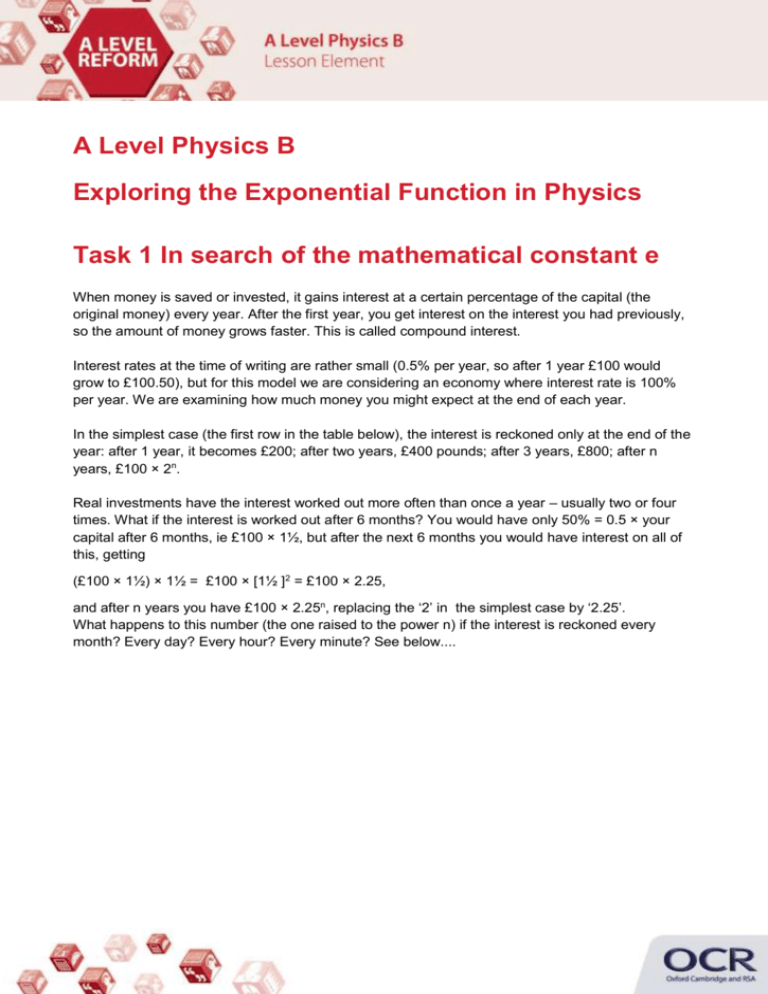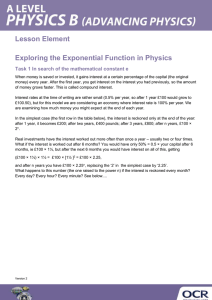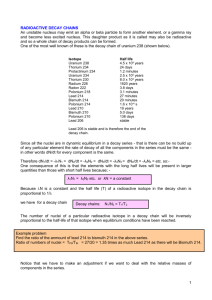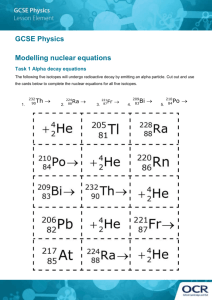Exploring the exponential function - Activity - Lesson element
advertisement

A Level Physics B Exploring the Exponential Function in Physics Task 1 In search of the mathematical constant e When money is saved or invested, it gains interest at a certain percentage of the capital (the original money) every year. After the first year, you get interest on the interest you had previously, so the amount of money grows faster. This is called compound interest. Interest rates at the time of writing are rather small (0.5% per year, so after 1 year £100 would grow to £100.50), but for this model we are considering an economy where interest rate is 100% per year. We are examining how much money you might expect at the end of each year. In the simplest case (the first row in the table below), the interest is reckoned only at the end of the year: after 1 year, it becomes £200; after two years, £400 pounds; after 3 years, £800; after n years, £100 × 2n. Real investments have the interest worked out more often than once a year – usually two or four times. What if the interest is worked out after 6 months? You would have only 50% = 0.5 × your capital after 6 months, ie £100 × 1½, but after the next 6 months you would have interest on all of this, getting (£100 × 1½) × 1½ = £100 × [1½ ]2 = £100 × 2.25, and after n years you have £100 × 2.25n, replacing the ‘2’ in the simplest case by ‘2.25’. What happens to this number (the one raised to the power n) if the interest is reckoned every month? Every day? Every hour? Every minute? See below.... Number of intervals per year Equation 1 £100 × (1 + 1)n 1+1 = 2 2 £100 × ([1½ ]2)n [1+ ½ ]2 = 2.25 12 1 12 £100 1 12 365 1 365 £100 1 365 What’s in the round bracket? n 1 1 12 12 = n = 8760 526 000 tending to infinity e = 2.718 281 828 459............ Continuously changing variables do need the number of intervals per unit time tending to infinity: that is why this number e occurs naturally in growth and decay equations. Task 2a Using Modellus to model radioactive decay Launch Modellus, then choose File... New. Type into the Model and Conditions window dN/dt=lambda×N where you use the space bar to get the multiplication symbol. Please keep to the upper/lower cases shown above. The equation appears as dN lambda N dt Press Enter at the end of this one-line model. The decay constant lambda (the Greek letter – Modellus doesn’t speak Greek) is the probability of any nucleus decaying in the time interval chosen; this is automatically displayed as seconds here, but it could be any time interval from ps (or smaller) to Ts (or larger). The equation reads as: rate of change of N = - (decay constant) × (number of nuclei originally present) Click Interpret and sub-windows for Parameters and Initial values appear In the Parameters section, set the decay constant lambda to 0.05, which will give each nucleus a 1 in 20 chance of decaying in each step. In the Initial values section, set the initial number of nuclei to 400 (or any value you like, really, but do remember that eg 0.5 nuclei has no physical meaning) Click Window…New graph and choose N for the y-axis. You will see that Modellus has already sensibly chosen t for the x-axis. Double-click somewhere near the bottom left hand corner of the graph window to move the origin of the graph. Click the start button on the bottom of the screen. After 20 seconds (the default duration of the run, which you can modify), click the Adjust button on the graph window; you can drag the corner of the window to see the axes clearly. You should see that this has modelled exponential growth (like the increase in the number of bacteria in a nutrient) instead of decay. This is because dN, the change in number of nuclei, should be negative, as the number of radioactive nuclei has gone down. Go back to the model window and type a minus sign in front of lambda in the first line. Click Interpret again. Now click the start button, and you should see the graph you expect. On the pull-down menu, choose Case...Add a case. Choose a different value of decay constant for the new case – sticking to simple multiples or submultiples of your initial values is best. On the Graph window, check the new Case box, and run both models together. How does the half-life depend on the decay constant ? If you want to see the values you can choose Window...New Table, highlight t and N, and choose the case you want; or you can run the model again, stop it when the y-axis value is half of the starting value and read the value from the x-axis. Task 2b Using Excel to model radioactive decay This task gives instructions to enable students unfamiliar with Microsoft Excel to create an iterative numerical model for radioactive decay. It is intended to show how applying a very simple mathematical rule allows the exponential decay curve to be produced. Creating the spreadsheet model Open a new spreadsheet, and type lambda into cell A1 and deltat into cell C1. You are going to type in the actual values for lambda () and deltat (t) into cells B1 and D1 respectively. To start with type 0.05 into B1 and 0.1 into D1 Type t in cell A2, N in cell B2, and deltaN in cell C2. These are the column headings. Type 0 into cell A3 and 800 (the initial value of N, usually written as N0) into cell B3. These, together with the values in B1 and D1, are the initial conditions for the model. In cell C3, type = $B$1*B3 This tells Excel that N is to be found by multiplying the current value of N by the value of , so that number decaying (N) = decay constant () × number you had to start with (N). The $ signs make sure Excel always goes back to the correct cell. In cell A4, type =A3+$D$1 This is to make each value of t exactly t (the value in cell D1) larger than the one above. In cell B4, type =B3-C3 which means that the new value of N is found by taking the last value of N from the last value of N. To make row 4 complete, click on cell C3, copy, then click on cell C4 and paste. This puts the same rule into D4 as into D3. If you click on these two cells separately, you will see (on the formula line) that the row reference in the cell C4 for N is one greater than in D3, going from B3 to B4, but the cell reference with $ signs stays the same at $B$1. To complete the spreadsheet, you now need to copy the formulae in the lowest row into all the ones below. Left-click on cell A4 and drag to select B4 and C4 as well, and release the mouse. The cursor becomes a hollow + sign. Move the cursor over the bottom right-hand corner of the selected rectangle, and the plus sign changes into a solid one. Left-click and drag vertically downwards as far as you need to go — down to t = 10 s should be enough. A 1 2 B lambda C D 0.05 deltat t N 0.1 deltaN 3 0 800 40 4 0.1 760 38 5 0.2 722 36.1 6 0.3 685.9 34.295 7 0.4 651.605 32.58025 Displaying the results Left-click on cell A2 and drag across to include B2, then continue down as far as you need. On the header ribbon, select Insert and choose Scatter (gram) and then choose the last option, which gives you dot-to-dot connection of the points without plotting the points themselves. Drag the graph up to the top of the spreadsheet. Right-click on the x-axis of the graph and add major gridlines, and then add minor gridlines. You should now able to change the value of the decay constant in cell B1 and investigate the relationship between half-life and . Extension Type ln N in cell D2 (ln N means loge N, the base e logarithm of N). In cell D3, type = ln(B3) and copy this formula down by dragging the cell’s ‘handle’ down the column. You can now plot this graph by selecting the A column and the D column from row 2 downwards (left-click on A2 and drag down to the bottom, hold down the Ctrl key, then left-click on D2 and drag down to the bottom) and you can insert the graph as described above. You should get a straight-line graph. What is the gradient? You can drag this graph until it is just underneath the other one, and observe what happens as you change the decay constant . Fig. 1: graphs for = 0.02 s-1 and t = 0.1 s










